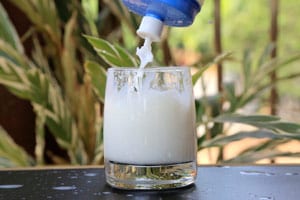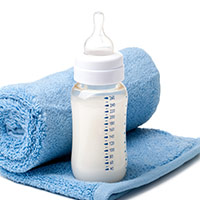Tips for Feeding Your One-Year-Old By baby’s first birthday, about half of what you will be feeding your one-year-old will be solids. Continue to feed most solid foods to your baby by spoon, since you are likely to get more food into baby’s mouth than on the floor. Yet, if your baby is the “do […]
- Home
- Topics (Page 54)
How Formulas Are Made
Using human milk as the nutritional standard, formula manufacturers follow a basic recipe that includes proteins, fats, carbohydrates, vitamins, minerals, and water. They combine various ingredients so that the nutrients in artificial baby milks follow the same rough proportions as human milk. The big difference between formulas is the different sources of these elements – […]
Comparision of Formulas and Breastmilk
To be fair, formula companies have produced milk for babies which, at least on paper, seems to resemble the real thing. Formula is definitely better than it used to be. But on close inspection, what the factories make doesn’t quite measure up to what mom makes. It is nearly impossible for artificial baby milk manufacturers […]
Choosing Formula

Be sure to choose a DHA-enriched formula. Most, if not all of the US formula companies will offer AA/DHA-enriched formulas. For information about the brain-building benefits of DHA, try Dr. Sears’ Go Fish DHA soft gels. When it comes to infant formula, parents need to know a few simple facts: There are some subtle differences […]
Soy Formulas?
Even though around 25 percent of formula-fed American babies take some form of soy formula, we recommend that parents begin their baby on a standard cow’s milk-based formula unless advised otherwise by their doctor. Soy formulas became popular as an alternative formula in infants who are allergic to cow’s milk. Some babies are less allergic […]
Follow-Up Formulas
A new trend in artificial baby milk, popular in Europe and now on the shelves in U.S. supermarkets, is formula designed for the infant older than six months and are meant to be a bridge between regular formula and cow’s milk, which should not be introduced until some time after age one. Two questions arise […]
Comparing Formulas
FORMULA NAME PROTEIN SOURCE FAT SOURCE(Find out if hydrogenated) CARB SOURCE Milk Based Formula Nonfat milk, whey protein concentrate: 60% whey, 40% casein Palm oil, high oleic (safflower or sunflower) Oil, Coconut Oil, Soybean Oil Lactose Soy Based Formula Soy protein Isolate Palm oil, high oleic (safflower or sunflower) oil, coconut oil, soybean oil Corn […]
Lactose-Free Formula
Special formulas are those in which one of the basic nutrients (usually the protein and/or carbohydrate) has been changed to an alternative nutrient that an individual baby may better tolerate. When formula shopping, be sure not to make a change to these specialty formulas without your doctor’s advice. Specialty formulas: are usually much more expensive […]
How Much and How Often to Feed

A Parent’s Guide: How Often to Feed Your Baby This is a very common question we get from parents in our office: How often to feed your baby. The feeding routine may change as your baby grows. The amount and frequency of feedings will also change as the months go by. Below are general guidelines that we recommend: Between […]
Safe Formula-Feeding Tips
Use before the expiration date on the label Use refrigerated, opened, ready-to-feed and prepared formula within 48 hours. Don’t leave bottles of formula out of the refrigerator for more than two hours. Throw away the formula left in the bottle after a feeding, since germs from baby’s saliva will multiply in the warm formula. Refrigerate […]
Bottlefeeding Tips
To make feeding time pleasant for you and baby, here’s how to get the most milk in and the most air up, and to do it safely. Giving the bottle: Most babies enjoy their formula slightly warmed; run warm tap water over the bottle for several minutes. Shake a few drops on your inner wrist […]
Sterilizing
A dishwasher with a water temperature of at least 180?F (82?C) will adequately sterilize bottles and accessories. If not using a dishwasher, try the following sterilization process. (Sterilize six bottles, or a daily supply, at one time.) After a feeding, thoroughly rinse the bottle and nipple under warm water and leave them on a clean […]
